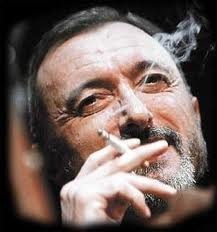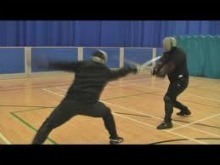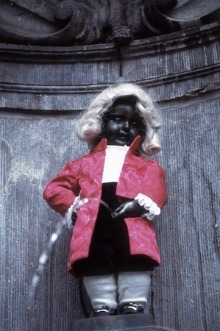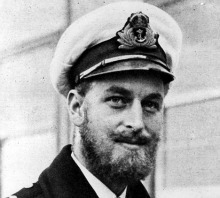Matt Rees's Blog - Posts Tagged "mozart-s-last-aria"
Signing up
 A book takes a long time to write, and then it takes a while to sell. And another while to sell in another country, and another after that. So a writer’s smile spreads across time.
A book takes a long time to write, and then it takes a while to sell. And another while to sell in another country, and another after that. So a writer’s smile spreads across time.My long-term grin widened this weekend, when I signed with my UK publisher for my next two books. Not only because Atlantic, the excellent publisher which has brought out all four of my Palestinian crime novels, bought my next books. But because Atlantic is launching a very exciting new imprint called Corvus.
The new imprint is headed by Nicolas and Anthony Cheetham, a father and son team who made Quercus such an important imprint. They’ve taken on my next book MOZART’S LAST ARIA, which is already completed and being edited in New York by the delightful Claire Wachtel at HarperCollins, and the novel I’m currently writing, which has the working title CARAVAGGIO ON FIRE. It’s about the Italian artist who, incidentally, is thought to have died 400 years ago on Sunday.
Writers will know what I mean when I say that signing the contract is a wonderful marker, but also similar to many other things in a writer’s life – it seems like a big milestone, but no one’s around to witness it except you, so you have to go inside yourself to enjoy the moment.
Read the rest of this post on my blog The Man of Twists and Turns.
Published on July 22, 2010 02:10
•
Tags:
after-sex, anthony-cheetham, atlantic-books, brooke-shields, caravaggio, caravaggio-on-fire, claire-wachtel, contracts, corvus, crime-fiction, greece, harpercollins, historical-fiction, mozart, mozart-s-last-aria, nicolas-cheetham, palestine, publicity, publishing, the-collaborator-of-bethlehem, thomas-m-kostigen, writing
Going historical
 Writing of the disdain expressed for genre novels by critics, Raymond Chandler said that there were just as many bad “literary novels” of the type favored by critics as there were bad genre stories – except that the bad literary novels didn’t get published. In other words, there’s nothing inherent in so-called genre fiction that makes it lesser than “literary” fiction.
Writing of the disdain expressed for genre novels by critics, Raymond Chandler said that there were just as many bad “literary novels” of the type favored by critics as there were bad genre stories – except that the bad literary novels didn’t get published. In other words, there’s nothing inherent in so-called genre fiction that makes it lesser than “literary” fiction.Chandler knew what he was talking about. His great noir novels, such as “The Big Sleep” and “The Long Goodbye,” are must-reads for anyone who wants to know how to build a sentence and a voice, how to create an image that won’t fade a few pages on, how to make people want to read it all over again. His contemporaries in the “literary” field who were more favored by the highbrow critics of his time are these days consigned to the dustbin of college literature courses. (If you don’t believe me, tell me when was the last time you reached for a volume by Upton Sinclair or Pearl Buck?)
But historical fiction is back. Ever since “The Name of the Rose” (published in English in 1983), the genre has accrued greater legitimacy. Last year’s Booker Prize went to a historical novel (“Wolf Hall”) and this year’s looks likely to go to “The Thousand Autumns of Jacob de Zoet” (do an internet search for its author David Mitchell and “genius,” and you’ll see why.)
Even poor old Alexandre Dumas and the swashbuckler have been returned from their long-ago burial under a mound of critical invective. In the last decade or so, Dumas has found his way into the title of a novel by Arturo Perez-Reverte, one of the most notable historical novelists of our time. Perez-Reverte can buckle a swash in the form of his Dumas-derived Captain Alatriste series, but he also has enough modern perversity for one of his novels to have been adapted for the screen by Roman Polanski. (That novel, “The Club Dumas,” even included a reference to Eco, “the professor from Bologna,” in a nod to his role in legitimizing the genre.)
Read the rest of this post on my blog The Man of Twists and Turns.
Published on September 01, 2010 00:06
•
Tags:
alan-furst, alexandre-dumas, arturo-perez-reverte, barbara-nadel, barry-unsworth, caleb-carr, captain-alatriste, caravaggio, crime-fiction, david-mitchell, hilary-mantel, historical-fiction, j-sydney-jones, literary-fiction, mozart, mozart-s-last-aria, new-york, omar-yussef, palestinian, pearl-buck, raymond-chandler, sacred-hunger, the-big-sleep, the-club-dumas, the-long-goodbye, the-name-of-the-rose, umberto-eco, upton-sinclair, west-bank, wolf-hall
New arms race--on author websites
 I have a new book coming out in the UK next spring. So it’s time to start looking around to see what new web gadgets and gismos authors are expected to shell out for from their meager advances to keep their “web profile” current.
I have a new book coming out in the UK next spring. So it’s time to start looking around to see what new web gadgets and gismos authors are expected to shell out for from their meager advances to keep their “web profile” current.It’s a new arms race. Just as the Soviets bankrupted their (morally bankrupt) regime trying to keep up with US developments in mass destruction, writers have to divert their attention from the writing of books and trawl the (morally questionable) web, wondering if people will think they’re bad writers just because they didn’t hire the most expensive web designer.
Many top writers still have websites whose homepages are essentially just tacky ads for their latest book. Those are sites you’ll never return to. You go there, read the author bio, and maybe click on “BUY THE BOOK!!!” Ha, as if.
So web designers are trying to figure out ways to get you to come back to a site which, by definition, ought only to be worth visiting every year or so, when the author actually publishes a new book.
Hence, you are invited download the Haruki Murakami screensaver, or demonic Bret Easton Ellis “wallpaper,” or play a Huckleberry Finn “vocabulary game” to entice you to visit the site of Jon Clinch, author of “Finn.”
And here I thought writing my own blog and this blog and maintaining a Facebook page and tweeting and...
Read the rest of this post on my blog The Man of Twists and Turns.
Published on September 26, 2010 04:24
•
Tags:
bret-easton-ellis, crime-fiction, finn, haruki-murakami, historical-fiction, huckleberry-finn, imperial-bedrooms, internet, jon-clinch, middle-east, mozart-s-last-aria, omar-yussef, palestine, palestinian, writers, writers-websites
Gentleman and thug: researching my new historical novel
 One of the great pleasures of novel-writing is the research which, for almost every book, ought to bring the writer to investigate different areas of inquiry. To become a swift expert in something others might spend all their lives studying.
One of the great pleasures of novel-writing is the research which, for almost every book, ought to bring the writer to investigate different areas of inquiry. To become a swift expert in something others might spend all their lives studying.That’s why I’ve taken up my sword.
I’m working on a historical novel about the great Italian artist Caravaggio. That has meant learning to paint with oils, which has been even more enjoyable than learning piano while writing MOZART’S LAST ARIA, the novel I have coming out in 2011. But Caravaggio wasn’t only a painter. He was also infamous for killing a man in a rapier duel.
Hence my visit to the Academy of Historical Fencing on my recent trip to the UK, where I learned that the rather dandified image of dueling is somewhat over-romanticized. “You could fight like a gentleman or like a thug,” says Nick Thomas, one of the brothers who founded the Academy. “But it was all about killing, in the end. So it could be said that the thug predominates.”
Nick is a delightfully obsessed martial arts fan who learned Renaissance Italian so he could translate his favorite fencing manual (Ridolfo Capo Ferro’s 1610 masterpiece the “Gran Simulacro”) and has won many European rapier competitions. By day he and his brother write zombie fiction (their latest is about "Sherlock Holmes and the Zombie Problem"). With several friends, he founded the Academy in 1996. They run classes in Bristol, England, and my hometown of Newport, Wales. So after putting my son to bed, I picked up my Dad in my rental car and zipped out to Caerleon University, where Nick awaited in the gym with his swords and daggers.
Read the rest of this post on my blog The Man of Twists and Turns.
Published on November 04, 2010 07:28
•
Tags:
academy-of-historical-fencing, bristol, caerleon, caerleon-university, caravaggio, crime-fiction, england, fencing, historical-fiction, mozart-s-last-aria, newport, nick-thomas, rapier, renaissance-italy, ridolfo-capo-ferro, sword-fighting, wales
Ikea and the Crime Writer
 There are many theories as to why Scandinavian crime writers prosper in the bestseller lists. But I know why it is. Ikea.
There are many theories as to why Scandinavian crime writers prosper in the bestseller lists. But I know why it is. Ikea.I just bought a new set of Ikea shelves for my office. I’ll get into exactly how that has altered the configuration of my workspace, but at this point let me just note that it makes my writing room seem a thousand times more orderly, less cluttered. As any feng shui expert would tell you, a disorganized room will yield fractured thoughts and fill the mind of its occupier with distraction. For a writer who needs to focus on his manuscript and whose manuscript requires a consistent vision, that’s a bad thing.
So these shelves, produced by a company based in Sweden, have no doubt created the clean, neat spaces Scandinavian crime writers like Henning Mankell and Jo Nesbo need to write their clean, neat stories.
I was in need of a little neatening in my office, because my research had started to create clutter. There were piles of books on Mozart, music and the Austrian Empire related to my forthcoming historical crime novel MOZART’S LAST ARIA. Then new mountains of books and documents for CARAVAGGIO ON FIRE, my novel about the Italian artist which will be out in a year and a half.
But that’s not all. For my Mozart book, I learned the piano. So suddenly there’s a piano in my office. For Caravaggio, I’ve been learning to paint with oils, so there’s an easel and painting implements and canvases jostling for space with my guitars and bass guitars and amplifiers (those aren’t research; it’s a hobby).
Add to that the large numbers of foreign editions of my books I’m delighted to receive when I’m published in Indonesia and Romania and Iceland, but which I’m unable to give to friends due to the fact that I only know one Icelander, my Romanian landlord already read the book, and the only Indonesian I know is my editor and of course he has already read the book, too.
Read the rest of this post on my blog The Man of Twists and Turns.
Published on December 09, 2010 01:07
•
Tags:
caravaggio, caravaggio-on-fire, crime-fiction, feng-shui, henning-mankell, iceland, ikea, indonesia, italy, jo-nesbo, mozart, mozart-s-last-aria, romania, sweden, the-guardian, writers-rooms, writing
Into costume: My book promo Pt. 1
 My new book MOZART’S LAST ARIA will be out in the UK in May. Naturally this means a revamp for my website (coming soon) and a new promo video (coming about the same time) to be posted to Youtube. You know, all the stuff writers actually get into the business of writing in order to do. That, and cashing the massive cheques, of course. Oh, and the groupies who throw their panties at you at book-store readings. And the drugs.
My new book MOZART’S LAST ARIA will be out in the UK in May. Naturally this means a revamp for my website (coming soon) and a new promo video (coming about the same time) to be posted to Youtube. You know, all the stuff writers actually get into the business of writing in order to do. That, and cashing the massive cheques, of course. Oh, and the groupies who throw their panties at you at book-store readings. And the drugs.Anyhow, that’s enough digression, even for a blog post. So back to the point: All my previous video clips – which can be viewed on my website – have necessitated no more than a jaunt to Nablus, Gaza or Bethlehem, where I’ve been filmed chatting about the latest adventures of my Palestinian sleuth Omar Yussef. This time, I have to recreate the world of Vienna, 1791, for my historical mystery.
For the novel, creating the atmosphere, the details and the locations of Vienna during Mozart’s time brought me to amass a few shelf-loads of research, to learn piano so I could play some Mozart, and to travel in Austria and Central Europe.
The video places a few more demands. This week I’ve been getting into costume.
I found a theatrical costume shop on a tiny alley in the oldest part of West Jerusalem just off Jaffa Road. Run by a delightful, bustling French lady named Francoise Coriat, the compact store is packed up and down (hanging from the ceiling too) with pirate suits, musketeer costumes, and every other period-wear you’d ever need. Mostly Francoise hires them out to theaters.
She kitted me out with two big flouncy dresses for the two female musicians who’ll feature in the video and three frock-coat suits for the men. And a Little Mozart costume for my three year old son.
Then it was time to figure out exactly how to film it. My videographer pal David Blumenfeld produces new equipment each year when it’s time for me to get a video done. This time he has a little slide to mount on top of his tripod; put the camera (these things are so small these days) on it and you can make a dolly shot that looks positively cinematic. His lighting is increasingly creative too. So I was sure it’d look great.
I worked up a script last week, aiming to make the video seem more like a movie trailer than the more documentary/journalistic style of most of my previous promos. Why? Well, first because MOZART’S LAST ARIA isn’t based on a topic you’re used to seeing featured in the news – whereas Palestinians, unfortunately for them, are very much in the news. Morever, it seems to me people are used to reading novels which are like movies – almost entirely visual, very little of the internal narrative of novels written a century ago – so perhaps book promotional videos ought to be that way too. This is how we think of stories these days.
True, said my friend Matthew Kalman, a journalist based here in Jerusalem who’s also a filmmaker. But beware, he said, that you don’t expect amateur actors to…act.
Read the rest of this post on my blog The Man of Twists and Turns.
Published on December 30, 2010 02:03
•
Tags:
austria, bethlehem, book-promos, book-videos, crime-fiction, gaza, historical-fiction, jerusalem, mozart, mozart-s-last-aria, my-books, nablus, omar-yussef, palestine, palestinians, videos, youtube-com
Enter character the Black Swan and Bruce Springsteen way
 A writer needs to enter the characters in his novel. I’ve talked about this with other writers, but also found it useful to discuss it with artists from other fields. Two movies I saw in the last week, “Black Swan” and “The Promise: The Making of Darkness on the Edge of Town,” illustrate just why it’s so important.
A writer needs to enter the characters in his novel. I’ve talked about this with other writers, but also found it useful to discuss it with artists from other fields. Two movies I saw in the last week, “Black Swan” and “The Promise: The Making of Darkness on the Edge of Town,” illustrate just why it’s so important.“Black Swan” revolves around the dilemma facing Natalie Portman as a ballerina cast as both the White Swan and the Black Swan in “Swan Lake.” The White Swan is no problem for her – she’s virginal and precise. But the seductive Black Swan is beyond her – she can’t loosen up and seems to be going crazy in her subconscious determination not to do so. Her director tries to drive her beyond the mere dance steps necessary for the role. The cliché would be to say he wants her to inhabit the role. But actually he wants the role to inhabit her.
That’s what makes the movie so compelling to watch as an artist. Because that’s the way it has to be. A writer has to be invaded and driven by his character. The other way around is too shallow, too distanced.
For a dancer like Portman’s character, there’s only one way to make the movements of your body convey emotion, and that’s to experience the emotion. To dance the Black Swan, you have to be able to step forward and say, “I’m the bloody Black Swan, dammit,” and for it to be true.
It’s the same for a writer. In the moment of writing about a particular character, all the writer’s reactions must come directly from the connection between the writer and the emotion at the heart of what he’s writing. If I ever experience a weak connection or a break, I can tell immediately: the words don’t come; or the most obvious character reaction suggests itself and instantly feels false.
I’ve developed techniques for entering into the character. They involve meditation and “breathing” through the heart, rather than the head. It opens you directly to the necessary emotion.
Read the rest of this post on my blog The Man of Twists and Turns.
Published on January 27, 2011 01:17
•
Tags:
adam-raised-a-cain, ballet, black-swan, bruce-springsteen, character, mozart, mozart-s-last-aria, natalie-portman, swan-lake, white-swan, writing
Ridiculous publicity ideas for authors
 In less than two months, my next novel MOZART’S LAST ARIA will be published in the UK (the US publication date is November). This means I have to start thinking about publicity.
In less than two months, my next novel MOZART’S LAST ARIA will be published in the UK (the US publication date is November). This means I have to start thinking about publicity.Naturally I’ll be doing the usual kinds of things that writers do these days. The promo video is already made and can be seen on www.mattrees.net. It will be particular hit with you if you want to see me wearing a powdered wig and silk stockings; it also features my adorable three-year-old son dressed as Little Mozart. One for the ladies, I’d say.
I shall be Facebooking, guest blogging, even tweeting perhaps, and sending emails to everyone who ever wrote an email to me. But all writers do that stuff.
So I shall also be adding some truly ridiculous publicity stunts to my “online presence.” Given that some of the other things necessary for publicity are a bit of a drag, my only criteria for my ridiculous stunts is that they ought to be fun.
For example, stay tuned for readings from MOZART’S LAST ARIA and some of my previous novels by major celebrities such as Michael Caine, Richard Burton, and Sean Connery.
Good publicity, eh? But surely expensive, you say.
Not if you work on your impersonations.
Read the rest of this post on my blog The Man of Twists and Turns.
Published on March 24, 2011 01:13
•
Tags:
blogs, crime-fiction, dame-edna-everage, michael-caine, mozart-s-last-aria, publicity, richard-burton, sean-connery, winston-churchill, yasser-arafat
Book publicity: the full set
 In the Royal Navy, there’s only one kind of facial hair allowed. British Tars are either clean shaven or they sport a beard, known in the service as a “full set.” The antipathy to the mustache is no doubt because of its predominance among the rival landlubber officer class (although it could’ve later been its association with a different kind of “sailor.”)
In the Royal Navy, there’s only one kind of facial hair allowed. British Tars are either clean shaven or they sport a beard, known in the service as a “full set.” The antipathy to the mustache is no doubt because of its predominance among the rival landlubber officer class (although it could’ve later been its association with a different kind of “sailor.”)Book authors now fall into similar categories. There are those who do nothing online and those for whom each book must be accompanied by the full set.
Those who do nothing are usually writers who were already well-known before the web became so important. They don’t need to be online, so they aren’t. Or they’re too old to get into a new kind of writing. Me, I have the internet full set. Here’s what I’ve got going on already for my new book, which is out in two weeks in the UK:
First there’s the updated website, www.mattrees.net. The website is, of course, the equivalent of facial stubble. Everyone’s doing it, even those who don’t get around to growing a full set. Some of them are pretty rotten and look like they’d itch… You can tell that the writer only sports the stubble because he thinks he has to – a fashion necessity. He’d get rid of it in a moment if the fashion changed.
I’m very involved in the design of my site. I put lots of Extra Features in it. You can hear much of the music from MOZART’S LAST ARIA, my new book. (It’s a historical thriller in which Mozart’s sister tries to uncover the secrets of the great composer’s death.) I have a couple of brief essays about how I came to write the book; how I researched it; how I structured it to mirror my favorite Mozart piano sonata. A photo tour of all the real locations featured in the novel, and images of many of the real characters from the book.
Read the rest of this post on my blog The Man of Twists and Turns.
Published on April 21, 2011 04:18
•
Tags:
caravaggio, crime-fiction, michael-caine, mick-jagger, mozart-s-last-aria, nannerl-mozart, orit-wolf, publicity, richard-burton, royal-navy, video, wolfgang-mozart, writers
My Mozart novel and the intifada
 If there had never been a Palestinian intifada, I might never have written my novel about the death of Mozart, MOZART’S LAST ARIA, which is published today in the UK by Corvus.
If there had never been a Palestinian intifada, I might never have written my novel about the death of Mozart, MOZART’S LAST ARIA, which is published today in the UK by Corvus.Of course, 4,000 people would also be alive who are now dead. In the course of writing about that destruction between 2000 and 2006, I saw some terrible things, experienced some frightful emotions, and internalized shocking facts about the world around me. It would’ve been easy to become depressed or to descend further into the post-traumatic stress disorder that nipped at my mind quite frequently.
Mozart saved me from that. I used to listen to his music in my armored car as I drove through the dangerous roads of the West Bank or on my iPod as I huddled in my Gaza hotel after a day dodging through refugee camps where Palestinians and Israelis were fighting it out. The Maestro’s great works soothed me, enabled me to achieve an emotional calm, when all around me was horror and chaos.
I didn’t use the music to ignore what was happening. Rather the music kept me open to the world around me. I didn’t have to shut out the horror; I could watch it and try to understand it. Because the great Wolfgang was sending me musical signals about the beauty and peace that exists at the core of every man. We only need listen to Mozart to know that he speaks to this part of us, and his immense popularity and immediacy is a sign that it truly is something we all possess.
There’s a good deal of research about Mozart’s music and its phenomenal ability to calm all kinds of disorders and, certainly, to soothe us when we’re stressed. Kids with attention-deficit disorder have been shown to concentrate better if Mozart is playing in their classroom. Epileptics are less likely to have seizures if they’ve been listening to Mozart (an element I worked into the plot of MOZART’S LAST ARIA.)
I found the last six symphonies were the most relaxing, and the piano sonatas. I think that’s because there’s an even greater clarity in these pieces than in some of Mozart’s other work. It’s also in these pieces that he hits the sonic frequencies particular to him which appear to be behind the curative effect of his music – frequencies scientists have found NOT to occur in other great composers like Beethoven or Brahms. (Listen to those other guys and it’ll be good for you, but it won’t really calm you and it certainly doesn’t have the same effect on A.D.D. or epileptics.)
Read the rest of this post on my blog The Man of Twists and Turns.
Published on May 01, 2011 00:28
•
Tags:
book-launch, crime-fiction, gaza, historical-crime, historical-fiction, intifada, ipod, israel, israelis, middle-east, mozart-s-last-aria, mozart-s-sister, murder-mystery, nannerl-mozart, palestinians, west-bank, wolfgang-amadeus-mozart, wolfgang-mozart



